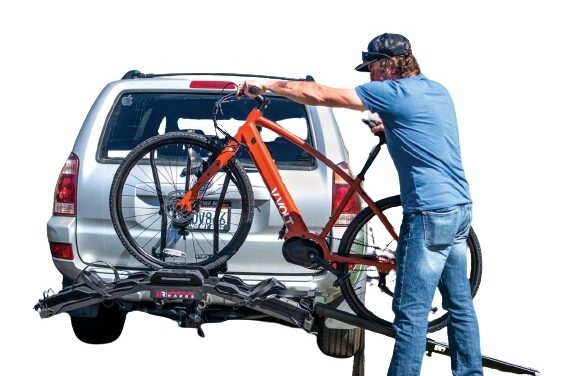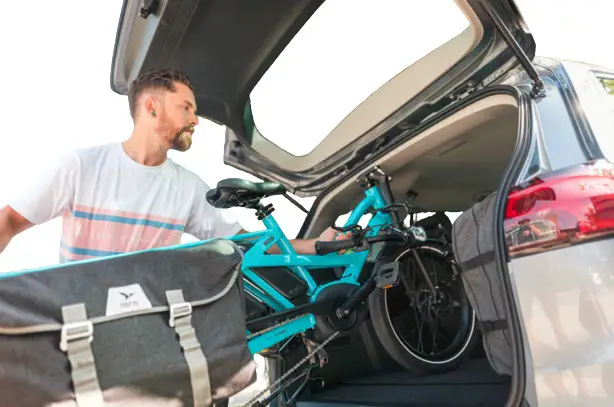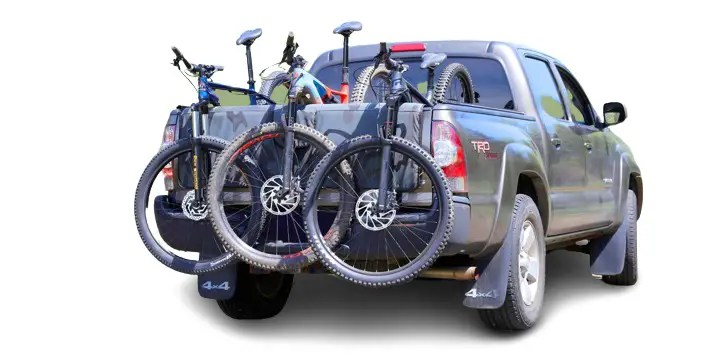Electric bikes have revolutionized the way people commute and enjoy outdoor activities. However, one of the challenges e-bike owners face is transporting their bikes safely and efficiently.
Knowing how to transport electric bikes to different locations can open up a world of possibilities for exciting adventures. It is essential whether you are planning a road trip, need to take your e-bike on public transportation, or want to fly with it.
In this comprehensive guide, we will explore the best practices and equipment for transporting electric bikes. We will also discuss various methods of transporting electric bikes, ensuring that you can travel with ease and convenience.
From car trunks to roof racks, we will explore the advantages and disadvantages of each method. This will help you make an informed decision. So let’s dive in and learn how to transport electric bikes effectively!
- Also Read: How Fast is a 1500W E-Bike?
- Also Read: E-Bikes For Winter
- Also Read: E-Scooters For Winter
- Also Read: Helmets For E-Bikes
How Do You Transport an Electric Bike?
You can’t just put your electric bike in your car if you want to bring it along on your next vacation.
You need a bike rack to attach it to the back of your car. But be careful, not all bike racks are suitable for e-bikes. Electric bikes are much heavier and bigger than regular bikes, so they need more support and space.
You have to check the weight and size of your e-bike and compare it with the bike rack’s specifications. Some electric bikes have different frames that don’t fit on regular bike racks. Therefore, you might need a special bike rack that is designed for such e-bikes.
What Bicycle Racks are Best Suited for Transporting E-Bikes?
If you want to transport your e-bike on a car, the best option is to use a bike rack that attaches to the towbar of your car. Some of these racks can even fold down with the e-bike on them, so you can still open the boot without any hassle.
You should avoid putting your e-bike on a roof rack. It is very hard to lift it up there because it is heavy. And you might damage your car or your e-bike if the roof can’t handle the weight.
If you don’t have a bike rack, you can try to fit your e-bike in the boot of your car. But you need a big boot for that, like a station wagon. And you have to be very careful not to scratch or dent your car or your e-bike when you load it.
What are the Regulations for Transporting Electric Bikes?
You need to follow some rules if you want to carry your electric bikes on a car’s boot rack.
These are the main ones:
- The bikes should not stick out more than 20 cm on either side of the car.
- You should take off any sharp or pointed parts or edges.
- The bike rack must have rear and brake lights and a valid license plate.
How to Secure Your Electric Bike on the Bicycle Rack?

You can get neoprene covers that are useful for keeping your e-bike safe and clean when you carry it on a boot rack. They also have protectors for the computers that you can’t take off.
You should also lock your e-bike on the rack to prevent theft. Some locks have sirens that will make a loud noise if someone tries to steal your bike.
Electric Bike Transport in the Rain
You should do the below things if you need to transport your electric bike in the rain:
- Take off the battery and computer if you can.
- Use the covers that came with your e-bike to cover the motor and the place where the battery goes. This will stop water and dirt from getting into the electronics.
Factors to Consider When Transporting Electric Bikes
Transporting electric bikes requires careful consideration of various factors. Understanding these factors will help you choose the most suitable method for transporting your electric bike. Here are the key considerations:
1. Weight
Electric bikes are generally heavier than regular bikes due to the additional components such as batteries and electronic systems. The weight of your electric bike will impact the choice of transportation method. It’s important to ensure that your chosen method can safely support the weight of your electric bike.
2. Frame and Shape
Electric bikes come in different shapes and sizes, making it essential to consider the frame and shape when choosing a transportation method. Some e-bikes have longer frames, while others have unique designs. The size and shape of your electric bike will determine whether it can fit inside a car trunk or on a specific rack.
3. Tires
The size of the tires on your electric bike will also influence the transportation method. Some racks may not be compatible with larger e-bike tires, while others are specifically designed to accommodate them. Consider the tire size when selecting a transportation option.
4. Battery Disposal
Electric bike batteries, typically lithium-ion, require special handling and disposal due to their sensitivity and potential risk of fire or explosion. Ensure that you comply with local regulations and airline restrictions if you plan to transport your electric bike by plane.
5. Transport Vehicles Types and Limitations
There are different ways to transport electric bikes by car, truck, bus, train, or even air. However, you need to consider the size and weight of your e-bike and the vehicle you are using.
If you have a minivan or a truck, you can easily fit most e-bikes in the back. You just need to remove the seat of the minivan or clear some space in the truck bed. You should also strap your e-bike to keep it stable during the ride.
However, if you have a regular sedan, you may not be able to fit every e-bike in the trunk. Even if you use a mount or a rack for your e-bike, you have to check the weight limit of the roof of your sedan.
For carrying e-bikes in a car, folding e-bikes are a good option. They are lightweight and compact, and you can fold them and store them in the trunk or the back seat.
Methods of Transporting Electric Bikes
Transporting Electric Bikes in a Car Trunk

If you have a car with sufficient trunk space, transporting your electric bike in the trunk can be a convenient and cost-effective option. Here’s how to do it:
- Measure your electric bike and assess if it can fit in your car trunk. You may need to remove the front wheel or fold down the rear seats to create enough space.
- Place a synthetic mat, blanket, or sheeting on the trunk surface to protect it from debris and chain oil.
- Carefully lift your electric bike, distributing the weight evenly, and place it in the trunk with the drivetrain facing up.
- If you have removed a wheel, use a spacer between the brake calipers to prevent them from closing against each other.
- Cover your electric bike with a blanket or towel to protect it and reduce visibility from outside.
- Secure any loose items or luggage to prevent them from damaging your electric bike during transportation.
- Drive cautiously, avoiding sudden stops or rough terrain that could potentially damage your electric bike.
Transporting Electric Bikes on a Roof Rack

Roof racks are a popular choice for transporting electric bikes, especially if your car has limited trunk space. Here’s what you need to know:
- Ensure that your roof rack is certified to support the weight of your electric bike. Electric bikes are heavier than regular bikes, so it is crucial to choose a rack that can handle the load.
- Remove the battery from your electric bike to reduce weight and prevent potential theft.
- Place a cover over your electric bike to protect it from rainwater, debris, and sunlight while on the roof rack.
- Lift your electric bike onto the roof rack, ensuring it is securely fastened with straps or locks.
- Be aware of height restrictions, such as low bridges or tunnels, as the added height from the electric bike on the roof rack may limit your vehicle’s clearance.
- Consider using additional locks for added security, as electric bikes can be prime targets for theft.
- Drive carefully and be mindful of the extra height and weight on your roof, especially during windy conditions.
Transporting Electric Bikes on a Trunk Rack

Trunk racks offer a convenient way to transport electric bikes, particularly if you don’t want to invest in a roof rack. Follow these steps for safe transportation:
- Choose a trunk rack that is compatible with electric bikes and can support the weight of your specific model.
- Attach the trunk rack securely to your vehicle, following the manufacturer’s instructions.
- Remove the battery from your electric bike to reduce weight and prevent theft.
- Position your electric bike on the rack, ensuring it is properly secured with straps or locks.
- Consider using a cover or protective padding to shield your electric bike from debris and potential damage.
- Check the stability of the trunk rack and electric bike before driving, making any necessary adjustments.
- Drive cautiously, avoiding sudden stops or rough roads that could cause your electric bike to shift or become damaged.
Transporting Electric Bikes in a Van or Pickup Truck

If you have access to a van or pickup truck, transporting electric bikes becomes even more convenient. Here’s how to do it effectively:
- Measure the interior space of your van or truck bed to ensure it can accommodate your electric bike(s).
- Remove the front wheel and battery from your electric bike to reduce weight and make it easier to load.
- Place a non-slip mat or blanket on the floor of the van or truck bed to prevent your electric bike from sliding.
- Lift your electric bike into the van or truck bed, ensuring it is stable and secured against any movement.
- If transporting multiple electric bikes, stack them carefully, using padding or protective covers to prevent scratches or damage.
- Secure your electric bikes with straps or bungee cords to ensure they remain in place during transportation.
- Drive cautiously, accounting for the added weight and potential movement of your electric bikes.
Other Options for Transporting Electric Bikes
You can also bring your e-bike with you on buses and trains when you are not driving a car. However, different transport companies may have different policies and fees for this.
Transporting Electric Bikes by Bus
E-bikes may or may not be allowed on long-distance buses, depending on the carrier. For instance, FlixBus only accepts folding e-bikes that can fit in the luggage compartment, but not regular e-bikes. Other companies may let you bring your e-bike, but they usually have limited space, so you should book early.
Transporting Electric Bikes by Train
Taking an electric bike on a train is usually simple and handy; most train operators treat an e-bike the same way as a regular bike. This means that you will pay the same price and follow the same rules as for a regular bike. Always check the specific regulations of the operator before you travel long-distance with your e-bike.
Transporting Electric Bikes by Plane
Electric bikes are hard to take on planes because they have lithium-ion batteries, which are seen as dangerous goods by most airlines. Some airlines might let you bring your e-bike, but they have strict rules and high fees: you need to pack your e-bike in a special box and send it as special cargo, which is a lot of hassle.
In most cases, it will be cheaper and easier to rent an e-bike when you get to your destination.
Tips for Transporting Electric Bikes
1. Security
When transporting your electric bike, it is essential to prioritize security to prevent theft. Consider the following measures:
- Use additional locks or security devices to deter potential thieves.
- Avoid leaving your electric bike unattended for extended periods, especially in vulnerable areas.
- Park your vehicle in well-lit and secure areas whenever possible.
2. Maintenance and Protection
Transporting your electric bike can expose it to various elements and potential damage. Take these steps to protect your bike:
- Use covers or blankets to shield your electric bike from rain, dust, and debris.
- Regularly inspect your electric bike for any signs of damage or loose components after transportation.
- Clean your electric bike, including the drivetrain, after transporting it to remove any accumulated dirt or grime.
3. Compliance with Regulations
Ensure that you comply with local regulations and laws regarding the transportation of electric bikes. This includes:
- Adhering to weight restrictions and load limits specified for different transportation methods.
- Following guidelines for proper disposal of electric bike batteries, especially when traveling by air.
Tips for Transporting Electric Bikes in or on a Vehicle
- You can carry your electric bike in the back of your vehicle if you have a van, SUV, or hatchback. This way, your bike and its parts (like brakes) will stay dry, clean, and free of contaminants.
- To make your bike fit better and lighter inside your vehicle, you can take off the front wheel and battery before loading it.
- When you transport your electric bike inside your vehicle, protect it from getting damaged or rubbed by covering it with a blanket and checking the cables and controls on the handlebar.
- If you choose to use a bike rack, check that it can handle the weight and size of your e-bike(s). You need a rack that can fit the wheel/tire or frame of your bike.
- The best bike racks for electric bikes are usually hitch/receiver-mounted, tray/platform-style racks. They are easier to load and unload, and more likely to support the load of one or more e-bikes.
- Before putting your bike on the rack, remove the battery. This will make your bike easier and lighter to load, and also prevent theft or loss of the battery.
- After your bike is on the rack, fasten it securely with the straps on the rack. You should also lock your bike for extra security.
- When you drive with your electric bike on the back of your car, you may want to cover your bike to avoid damage and contamination.
Conclusion
Transporting your electric bike opens up a world of possibilities for exciting cycling adventures. By considering the weight, frame, tires, and battery disposal, you can choose the most suitable method for transporting your electric bike.
Whether utilizing a car trunk, roof rack, trunk rack, or van/pickup truck, prioritize security, and protect your electric bike from potential damage. With this comprehensive guide, you can confidently transport your electric bike and embark on new cycling experiences with ease. Happy riding!


Pingback: Why Are Electric Bikes So Expensive?
Pingback: Electric Bikes for Camping: A Comprehensive Guide
Pingback: 10 Best Electric Bikes for Off Road in 2024